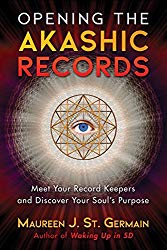
Opening the Akashic Records: Meeting Your Record Keepers and Discover Your Soul’s Purpose, by Maureen J. St. Germain
Bear & Company, 9781591433385, 176 pp., 2019
Maureen J. St. Germain is a mystic and teacher with more than 25 years of experience with the mystical and sacred traditions. Through her personal connections, she channels angels, divine feminine energy, dragons, Hathor (an Egyptian goddesses), and ascended masters.
Opening the Akashic Records: Meeting Your Record Keepers and Discover Your Soul’s Purpose discusses the akashic records, a vast ethereal library of cosmic knowledge that has existed as long as life itself. The akashic records are said to be a repository of everything which has happened in the past, all that is happening in the present, and all future possibilities. St. Germain states, “the Akashic Records are like a film library that allows instant access.”1 According to akashic theory, anyone with the right know-how may access the records.
St. Germain opens the book with a message, which she has channels from the Keepers of the Gates of Akasha. This message introduces the keepers and explains the premises and purposes of the records. The preface then explains how St. Germain came to be a messenger for the akashic records. This is the foundation of the book and rests on the notion that the Keepers of the Records have chosen this time to allow people access to attain enlightenment and increase their spiritual awareness.
In subsequent chapters, St. Germain goes on to explain what you can learn from the records, the role of prediction, what happens when you go into the records, and how you can obtain knowledge there. Using channelling, St. Germain also introduces the sponsors, or ascended masters, who are the gatekeepers of the records. These are here known as the Great Divine Director, the Goddess of Liberty, Lord Sanat Kumara, and Lord Metatron. “Calling upon the Ascended Masters ensures your success. This is another reason we ask the Ascended Masters by name to sponsor us and show up,” St. Germain writes.2 St. Germain also provides photographs to help readers visualize the ascended masters.
Humanity has been given access to the records in order to reap the maximum learning from their mistakes and to be able to ask about their personal experiences and understand them more fully. In order to help the reader on this path, St. Germain provides sample questions and sample answer from both the higher self and the ascended masters.
The second half of Opening the Akashic Records equips the reader with the tools needed to access the records. These include a sacred opening prayer, exercises in how to access your higher self, and exercises in opening the akashic records. The book provides ample exercises and tips for maximizing your experience within the records. For example, one of the exercises I found most useful was “Questions for Your Higher Self and Akashic Records.”3 This exercise is designed to develop your connection with both your higher self and the records. It does so by means of a series of questions, such as “What is the meaning of wonder?” and “How do I stay in my joy?”4 By seeking answers to these questions you begin to strengthen your connections. St. Germain gives sample answers from her other students to compare your answers to.
One of the ways this book differs from many other books about the akashic records is that it introduces specific akashic guides by name. In this sense, it claims to be an authority on the records. Many readers may not be comfortable with this idea and prefer to find their own personal akashic guides. However, the exercises in the book may still be used without calling on specific guides by name.
Opening the Akashic Records is a great book for anyone who wishes to take their first steps in the akashic records as it explains the steps to attain this goal in detail. It also presents a number of easy to follow exercises for the novice to practice with. Interestingly, it also provides advice on how to read the akashic records for others.









